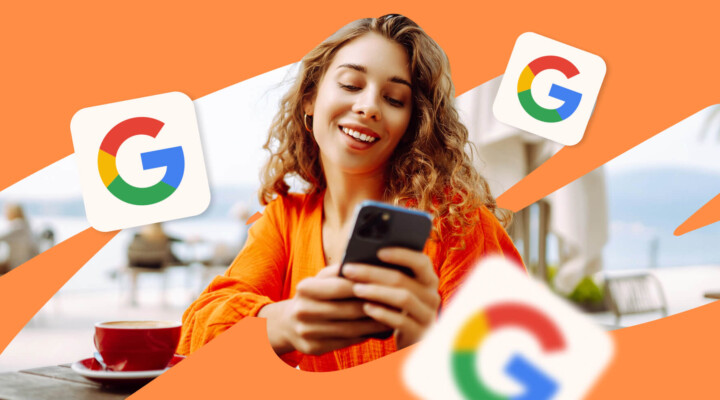Alexa Meisler is the founder of 52 Perfect Days, a travel website that helps readers spend a perfect day in different places around the world, and Break into Travel Writing, a website and podcast that teaches listeners how to start a travel blog. Alexa is a freelance writer and brand ambassador for multiple travel brands, such as Anatomie Travel, Clothes, WishGarden Herbs, Travelpayouts, etc. She also runs the Travel Writer Academy, which is designed to help bloggers improve their writing skills. Finally, Alexa is a mom, wife, traveler, red wine aficionado, and a gluten free foodie.
The power and benefits of Facebook ads
With the right approach and proper knowledge, Facebook ads can help you reach impressive results by increasing:
- Affiliate income
- Ad network income
- Website pageviews
- Audience and email list
- Brand awareness
- Visibility
Facebook ads can be a great investment tool that turns $1 a day into earnings of $1,825 a year (minus your daily investment). That’s a profit of $1,460 per year! Once you find your magic “cash cow”, your website may generate a decent regular income.
To do this, you need to define the articles worth promoting and optimize them for monetization, as well as create and test appropriate ads. The number of clicks and conversion rate will show you which articles have to be presented to the right people to achieve your goal.
Then, you need to retain your audience’s attention, make them click on your Facebook ads, and land on your optimized article. If you do this with the wrong articles, all your efforts will be a waste of time. Basically, it all comes down to three key points:
- Understand what articles to promote
- Optimize those articles
- Create good Facebook ads
As an aspiring blogger, you might doubt whether your blog is old enough or whether you have enough traffic to compete against top bloggers in the niche. If you manage to monetize articles and drive traffic from Facebook, you will become a strong competitor and earn an income from your website.
For starters, take a look at major blogs on your topic and see how they are monetized. Alexa shares [7:50] an example of how to analyze blog monetization strategies for the keyword “where to stay in Paris”. In this case, the number one post on Google’s search results is from Misstourist.com, which is filled with affiliate links to hotels and ads from the AdThrive network.
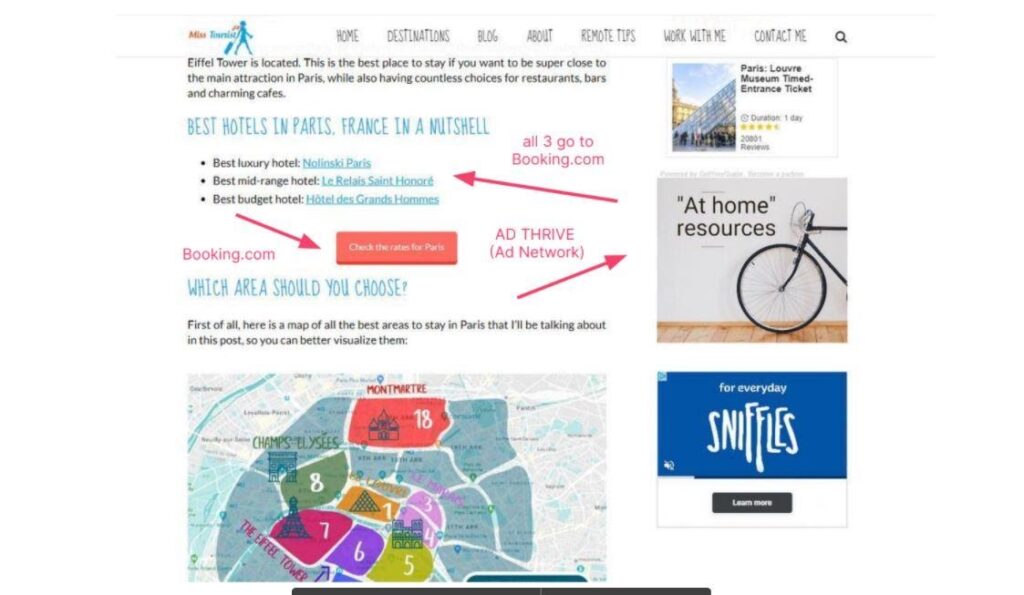
Another example is from the Adventurous Kate blog, which contains affiliate links to different hotels and Airbnbs, as well as ads from the Mediavine ad network.
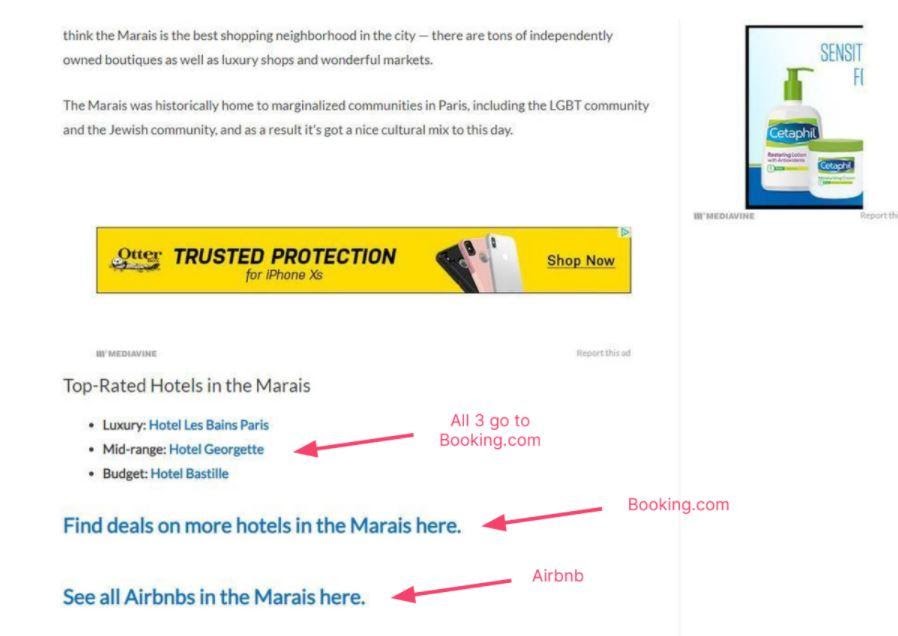
These articles are cash cows for their authors that regularly generate traffic and income. To find a cash cow of your own and drive traffic with Facebook ads, be sure to choose articles worth promoting and optimize them.
Choosing the right content to promote
To understand which articles are worth promoting, use analytic tools, such as Google Analytics, Pinterest, Affiliate Analytics, or Google Trends, and check in with your affiliate manager to receive feedback.
Google Analytics
This is a great free tool that allows you to find out which of your existing articles are gaining momentum and generate the most organic traffic. Check data for the last 30 days, the last three months, or the same month last year. Doing this can provide you with important insights into which articles require updates and can be given a second life. You can then monetize them, for instance, using Facebook ads or affiliate marketing.
Using Pinterest analytics, you can get an overview of which articles get the most saves, clicks, and engagements, and then drive traffic to your website using those articles. Scrolling through your article index can also show you which posts simply need to be polished, remarketed, and pushed to the homepage again.
Create new pins for your articles and see if they get some traction after proper optimization and monetization.

Affiliate marketing
Check your affiliate analytics for spikes and find articles with consistent levels of traffic. Check Amazon, Google Analytics, Travelpayouts, ad networks, etc. on a regular basis. Don’t miss your chance of pushing an article that is going viral. If there is one, it may be worth double-checking all the links inside it to make sure that they are still valid and monetized. For instance, a link may be “broken” if a product is no longer available or if an advertiser has left that affiliate network.
Alexa reveals [14:50] that checking affiliate analytics is part of her daily routine and recommends bloggers do the same to make sure they can act fast based on their statistics.
Google Trends
This tool allows you to search for the main trends and terms in the niche as well as filter the results by region, timeframe, etc.
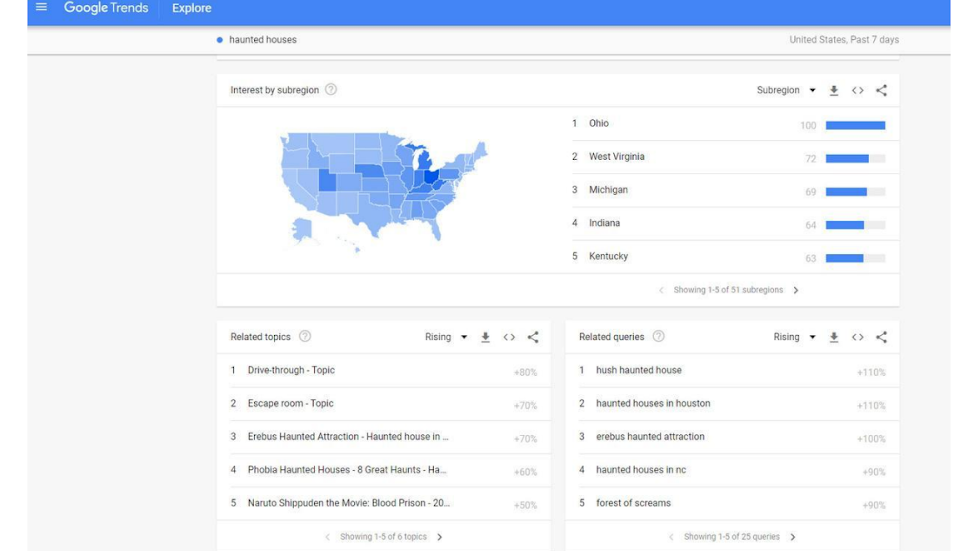
Use your brain
Look at your article index and find posts that need marketing help, such as an article from three months ago or from a year ago. First, make sure the post/article is properly optimized and monetized, then remarket it. You can start with Pinterest by creating a few pins for these posts and see which ones get traction.
Alexa shares an example of remarketing an old post of hers that was driving organic traffic. She made sure the post had affiliate links in place and created a Facebook ad that increased traffic to the article, as well as affiliate revenue. Thus, be sure to act fast if you see an article trending and gaining momentum.
Take advantage of keyword research tools, such as SEMrush, Ubersuggest or Keysearch, to analyze top travel blogs and find their top-ranking keywords.
Finally, think strategically and take advantage of the current trends, like holidays, seasons, trending topics, events, etc. Alexa gives examples [22:30] of such trends and how to use them to your benefit.
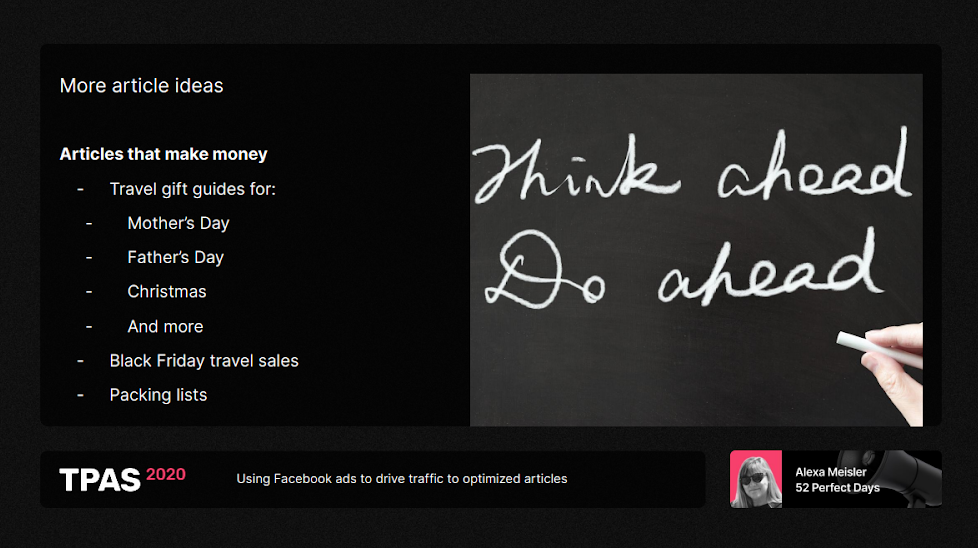
Articles not worth promoting
Articles without optimization are an absolute no when it comes down to promotion. Storytelling, personal points of view, and generalized articles tend to be more expensive to promote with Facebook and harder to monetize.
Learn how to optimize articles for monetization
So, now that you’ve found posts to remarket, it’s time to properly optimize them.
- Don’t fill your articles with tons of keywords, as doing so does not guarantee more income.
- Define the goal of your article: specific articles do way better than random ones.
- Showcase appropriate affiliate links where possible. Alexa illustrates [24:40] this with an example of her own.
- Check with the experts. Contact the affiliate programs that you are working with and ask about their highest converting programs, tours, and deals.
- Test your ideas. Test different affiliate partners, article layouts, fonts, colors, and text. Once you find your perfect recipe, you will see real results.
- If you feel lost, do some research. Analyze some top blogs and check to see how they create their content. Use them as inspiration and a starting point for your own unique content.
Create fun and engaging Facebook ads
Creating Facebook ads for blogs can help in a multitude of ways, such as increasing your income, web traffic, and brand awareness. In general, there are four ways to earn income by driving traffic with Facebook ads:
- Affiliate networks, such as Travelpayouts, are the best way to monetize travel articles, as they allow you to market airline tickets, tours, rental cars, hotels, etc.
- Direct affiliate programs, such as Anatomie, Luxury Travel Clothes, and WishGarden Herbs.
- Ad networks, such as Ezoic, Mediavine, and AdThrive, are a great way to build passive monthly income.
- Amazon’s affiliate network works well for packing lists, gift guides, and product reviews.
Creating Facebook ads
Your key objective is to drive traffic to specific articles on your website that are monetized. Creating a Facebook ad consists of several steps:
- Name your campaign and add a budget
Alexa suggests [30:53] that you start between $1 and $5 per day. At this stage, you want to determine which ads perform best, only then should you increase your daily spending. Also, at this step, choose the lowest cost-for-bid strategy.
- Choose automatic placements
Facebook marketing experts advise using auto-placement for ads when your goal is driving traffic. Here, you can choose “link clicks” for your optimization method. Otherwise, you will potentially pay for just engagement and likes.
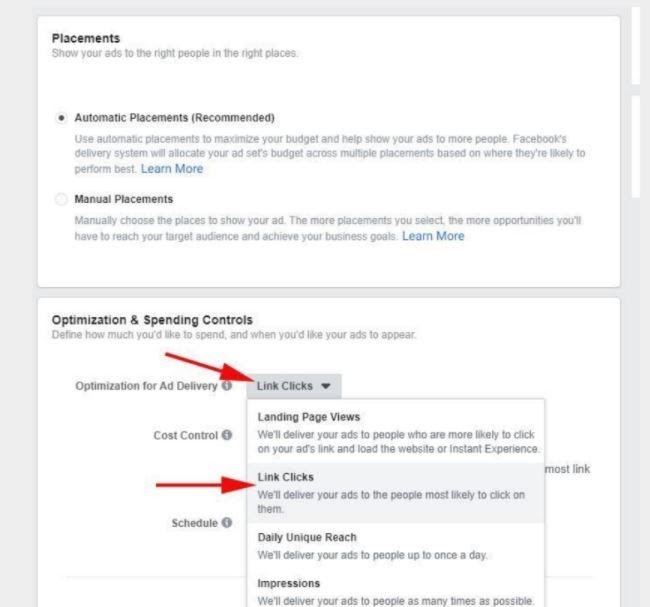
- Create your audience
Now, you are going to target with your ads. Decide who your audience is, as well as their age and location. You can also set up gender and language filters. Be strategic and think about who will find your article most interesting.
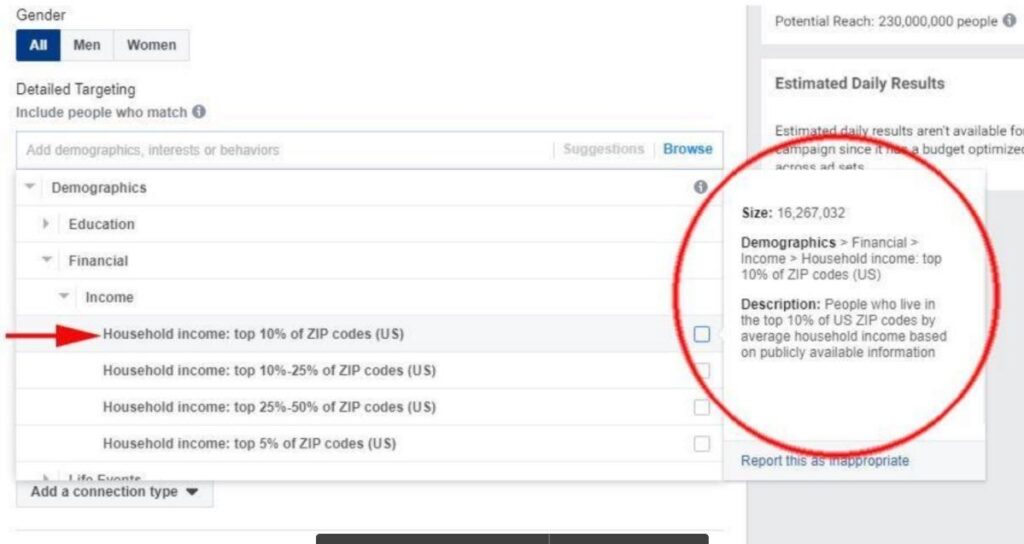
- Indicate behavior interests and demographics
Determine the financial behavior of your audience and target based on average income. You can actually target people with money as well as choose different types of behavioral categories, such as engaged shoppers, newly-engaged people, or travelers.
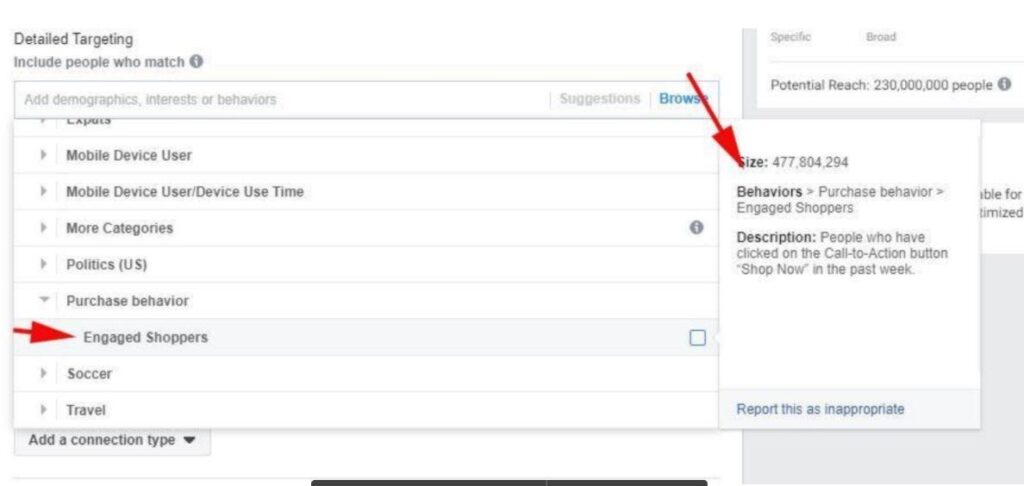
You need to do some research to explore who your audience is and how to create the best kind of ad. In general, the wider the range of location, age interests, and behavior, the lower your click-through cost will be. But if your ads are not reaching the people who might click them and possibly make a purchase, you’re not doing yourself any favors.
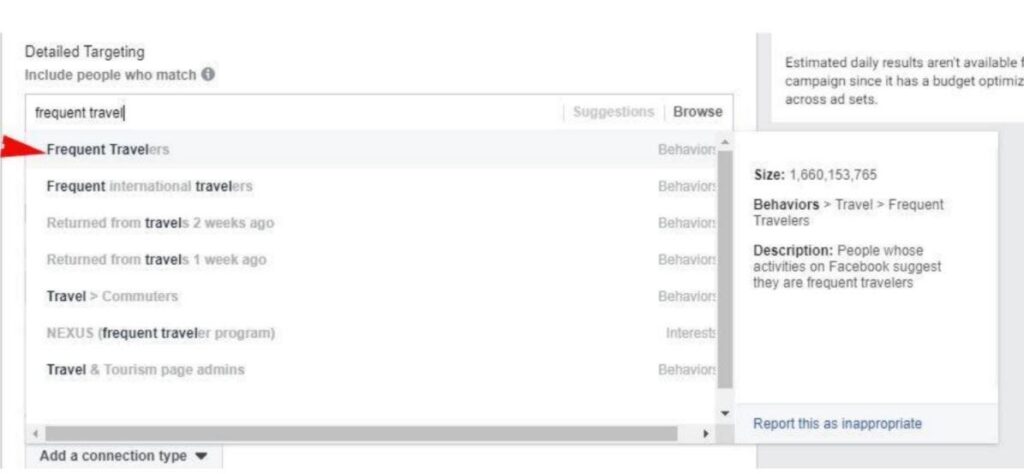
- Choose your final audience and click the “Save audience” button
You can reuse the audience settings for a future ad or even create a lookalike audience from here.
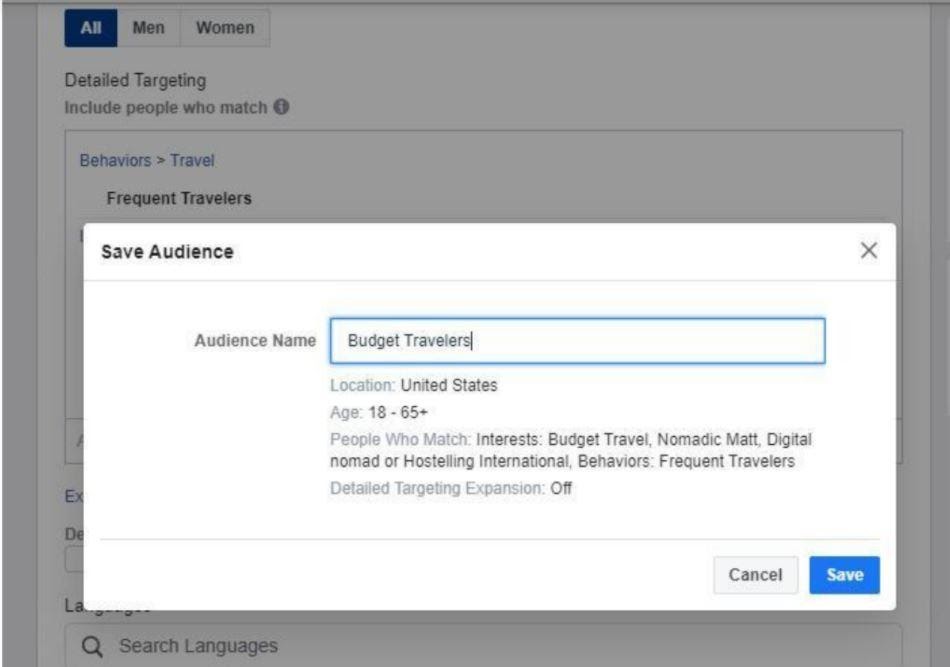
- Create an ad
Everything comes down to the attention span of your audience. Ideally, you want a three-slide slideshow or a six-second video (maximum 15 seconds). Facebook has templates or you can build one from scratch.
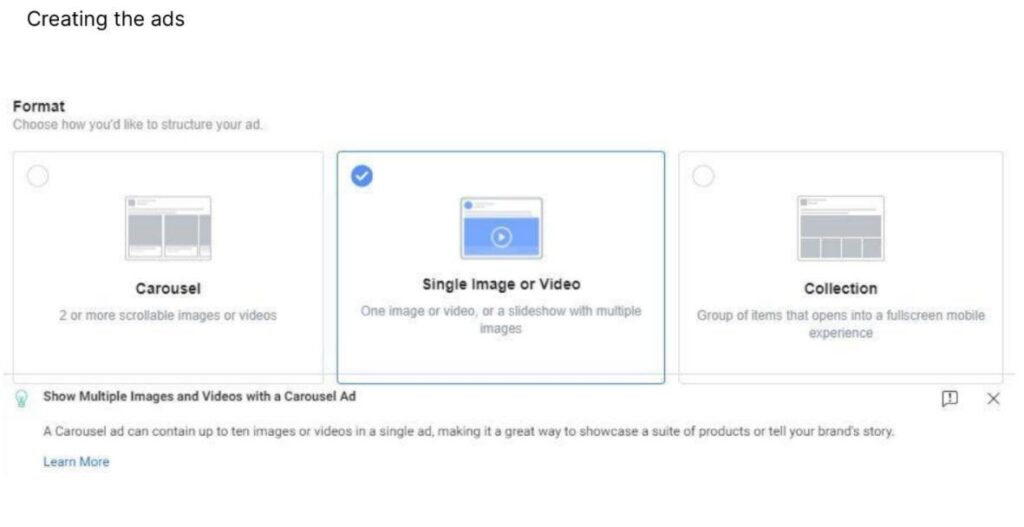
When creating your slideshows, try using video format as they perform well at a low cost. Here, you are free to choose your format, length, and images.
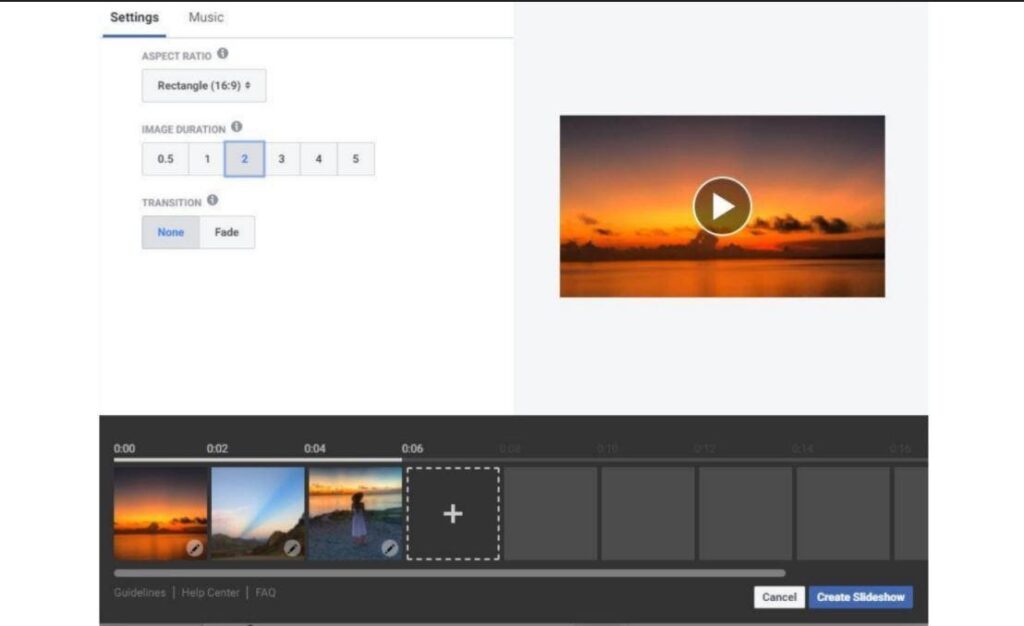
Also, you can choose the size and orientation for your presentation after adding your text, headlines, subtext, and website article URL. Keep in mind that a good headline matters.
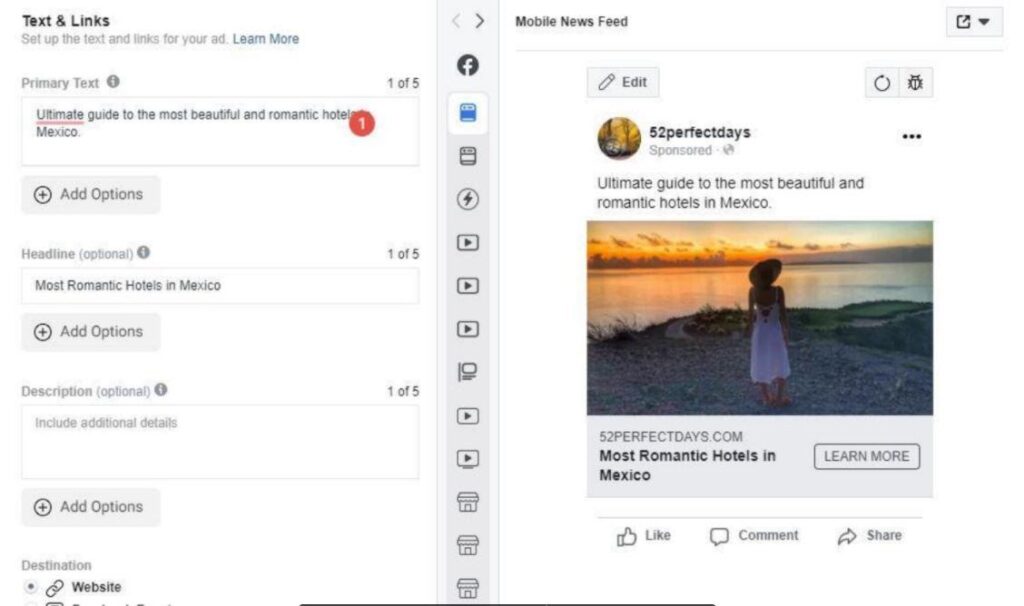
One additional piece of advice: When creating your ads, start with $1 to $5 a day and then create multiple versions of your best performing ads. Don’t forget about testing. You may even want to create a few versions of an ad to see which one performs better.
To make the best of ad campaigns, Alexa shares [38:27] that when she sees an ad doing well and generating click-throughs at a low cost, she increases the daily spending on that ad and turns off spending on all the other ads in that set.
When you manage to make ads work, these efforts will likely translate into consistent monthly income. In the end, it’s all about creating Facebook ads that convert to clicks and choosing optimized articles with affiliate links.
Presentation
You can download the presentation from the webinar at this link.

